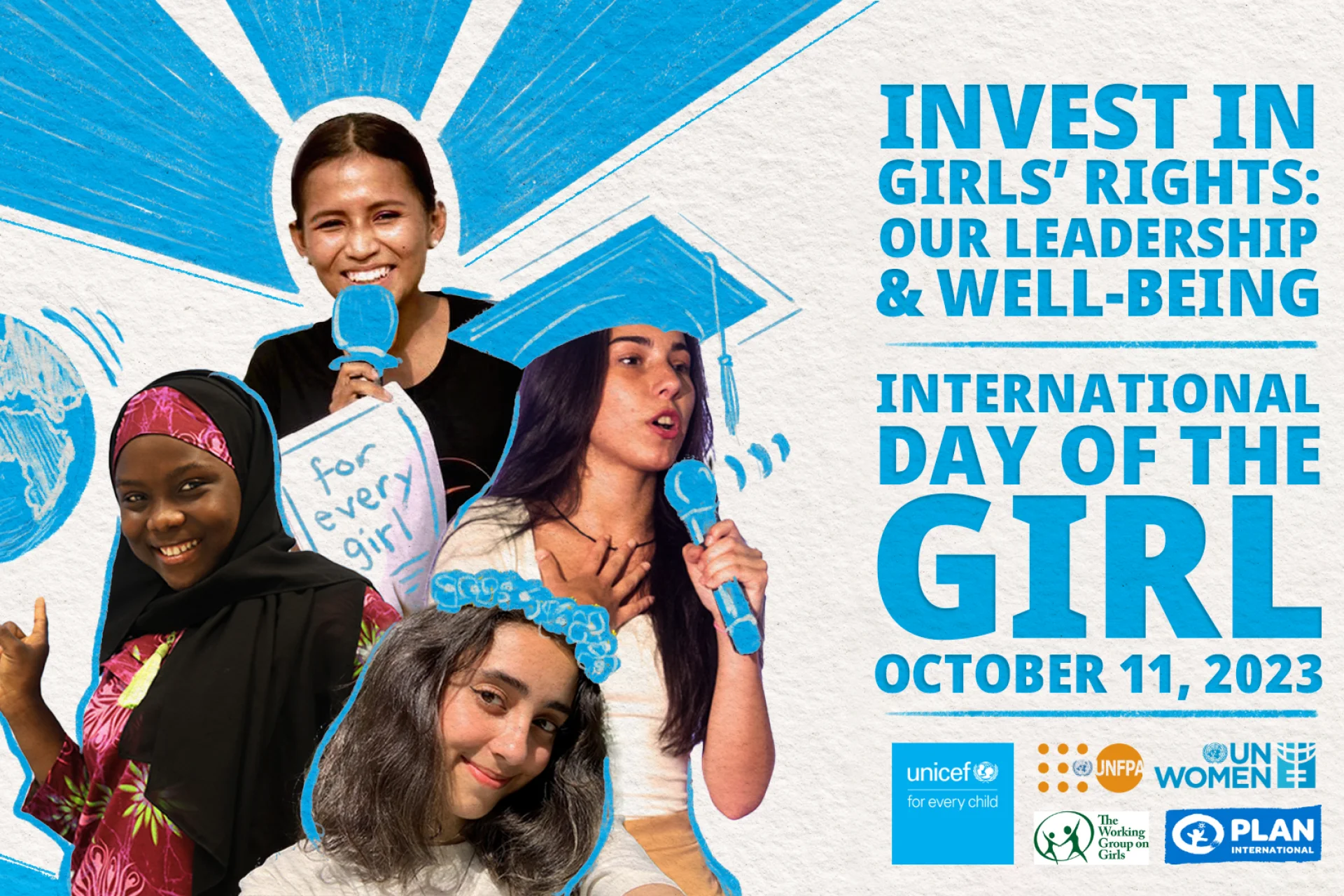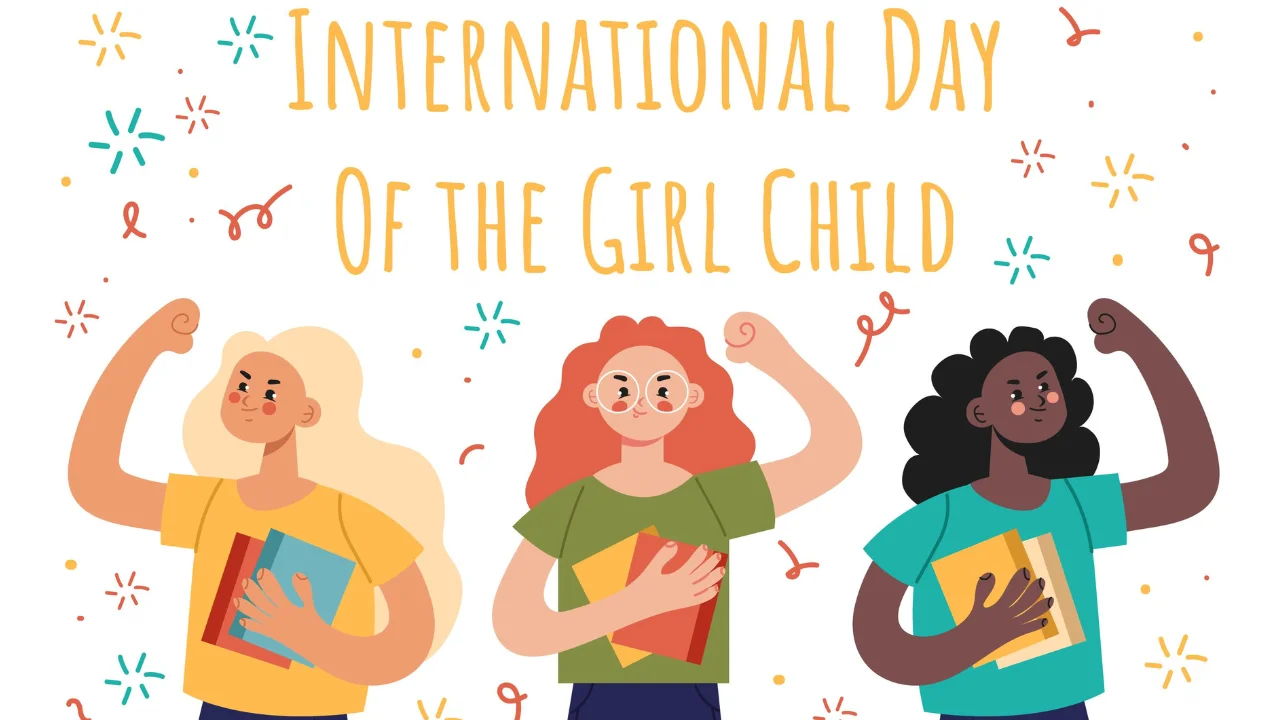International Day of the Girl Child 2024
The International Day of the Girl Child is celebrated annually on October 11 to raise awareness of the challenges faced by girls around the world and to promote girls’ empowerment and the fulfillment of their human rights.
International Day of the Girl Child Theme 2024
As of today, the theme for the International Day of the Girl Child 2024 has not been announced yet.

The theme in 2023 was “Invest in Girls’ Rights: Our Leadership, Our Well-being.” UNICEF and its partners are calling for a $1 billion increase in investments for adolescent girls. This comes at a crucial time when there are efforts to restrict the rights of girls and women and roll back progress on gender equality. Girls are particularly affected by these challenges.
To support girls in realizing their rights and reaching their full potential, there is a need for increased attention and resources in various areas. These include maternal healthcare and support for adolescent mothers, digital and life skills training, comprehensive sexuality education, survivor support services, and violence prevention programs. It’s essential to move beyond mere commitments and take bold actions to bring about change.
Girls themselves are often at the forefront of advocating for solutions and change in their communities. UNICEF envisions a world where girls have a voice in shaping government policies, influencing business practices, and directing research and innovations. This should become the norm rather than an exception.
History of International Day of the Girl Child
In 1995, at the World Conference on Women in Beijing, countries unanimously adopted the Beijing Declaration and Platform for Action, which is a highly progressive blueprint for advancing the rights of women and, notably, girls. This declaration was the first to specifically address the rights of girls.
On December 19, 2011, the UN General Assembly adopted Resolution 66/170. It officially declared October 11 as the International Day of the Girl Child. This day is dedicated to recognizing the rights of girls and raising awareness of the unique challenges they face worldwide.
The 2030 Agenda for Sustainable Development, along with its 17 Sustainable Development Goals (SDGs), was adopted by world leaders in 2015. These goals provide a comprehensive roadmap for sustainable progress that leaves no one behind. Gender equality and women’s empowerment are central to each of the 17 SDGs. Ensuring the rights of women and girls across all these goals is essential for achieving justice, inclusivity, equitable economies, and the sustainable well-being of our shared environment for present and future generations.
Significance of International Day of the Girl Child
The International Day of the Girl (IDG) – observed annually on 11 October – is a global platform to advocate for the full spectrum of girls’ rights.
The International Day of the Girl Child is an opportunity to raise awareness of these challenges and to call for action to improve the lives of girls around the world. It is also a day to celebrate the achievements of girls and to promote their empowerment.
Investing in girls is one of the best investments we can make. When girls are empowered, they can reach their full potential and contribute to their families, communities, and countries.
Challenges Faced by Girls & Women
In nearly every country, deeply entrenched patriarchal norms and power dynamics confer significant advantages to boys over girls across various aspects of life. These disparities become more pronounced during adolescence. Social and gender norms often limit adolescent girls’ access to public spaces, encourage them to be compliant and obedient (“good girls”), and reinforce the idea that their appearance and roles in caregiving are more valued than their education, leadership potential in business, or participation in policymaking.
This divergence in paths during adolescence is accompanied by a multitude of challenges and interconnected violations of girls’ rights. Due to patriarchal dynamics operating at multiple levels — from formal policy-making institutions to community norms, family behaviors, and individual attitudes.
How girls are left behind in various dimensions?
- Education: Nearly 1 in 5 girls globally do not complete lower-secondary education, and almost 4 in 10 do not complete upper-secondary school. The numbers are even worse in specific regions. In low-income countries, approximately 90% of adolescent girls and young women do not use the internet, while their male peers are twice as likely to be online.
- Unpaid Care Work: Girls aged 5-14 spend 160 million more hours each day on unpaid care and domestic work than boys of the same age. This unequal distribution of unpaid work intensifies during adolescence, negatively impacting girls’ well-being.
- Health: Adolescent girls continue to represent three-quarters of new HIV infections among adolescents.
- Family Planning: Progress in meeting adolescent girls’ demand for modern family planning methods has been slow, with only a modest increase from 55% to 60% since 2012. This means that 4 in 10 adolescent girls aged 15-19 who wish to avoid pregnancy are not using modern contraceptive methods. It contributes to teenage pregnancy, a significant cause of mortality for adolescent girls.
- Child Marriage: Even before the COVID-19 pandemic, 100 million girls were at risk of child marriage in the next decade. The pandemic has exacerbated this issue, with up to 10 million more girls worldwide at risk of marrying as children in the next ten years.
- Violence: Nearly 1 in 4 married or partnered adolescent girls aged 15-19 have experienced physical or sexual violence from an intimate partner at least once in their lifetime.
Addressing these deeply rooted gender inequalities and empowering adolescent girls is crucial for achieving gender equality and the overall well-being of societies worldwide.
Conclusion – International Girl Child Day 2024
Investing in adolescent girls is not only a matter of human rights but also a strategic choice with far-reaching economic and societal benefits. Targeted and evidence-based investments in areas that promote girls’ leadership and well-being are crucial to securing their rights and contributing to their development in all settings and contexts.
Investing in adolescent girls is not only an ethical obligation but also a wise investment in a brighter future. It not only empowers girls themselves but also benefits their families, communities, and societies at large. Such investments are not only aligned with international conventions but are also essential for achieving the Sustainable Development Goals and building a more equitable and prosperous world.
11th October 2024 Special Day
On October 11, 2024, the International Day of the Girl Child takes center stage, an annual celebration dedicated to raising awareness about the challenges faced by girls worldwide. This special day advocates for girls’ empowerment and the fulfillment of their human rights. Let’s stand united in acknowledging the potential of every girl, promoting inclusivity, and working towards a world where girls are empowered, educated, and given the opportunities they deserve to shape a brighter future.
- Weekly Current Affairs 2025 PDF For Bank, SSC, UPSC Exams
- Unsung Heroes of India: 10 Unknown Freedom Fighters You Should Know
- 26 December Current Affairs 2023 in English
- Daily Current Affairs 2025, Check Today’s Current Affairs
- April Month Current Affairs 2024, Download PDF
- June Month Current Affairs 2024, Download PDF

Hello, I’m Aditi, the creative mind behind the words at Oliveboard. As a content writer specializing in state-level exams, my mission is to unravel the complexities of exam information, ensuring aspiring candidates find clarity and confidence. Having walked the path of an aspirant myself, I bring a unique perspective to my work, crafting accessible content on Exam Notifications, Admit Cards, and Results.
At Oliveboard, I play a crucial role in empowering candidates throughout their exam journey. My dedication lies in making the seemingly daunting process not only understandable but also rewarding. Join me as I break down barriers in exam preparation, providing timely insights and valuable resources. Let’s navigate the path to success together, one well-informed step at a time.






